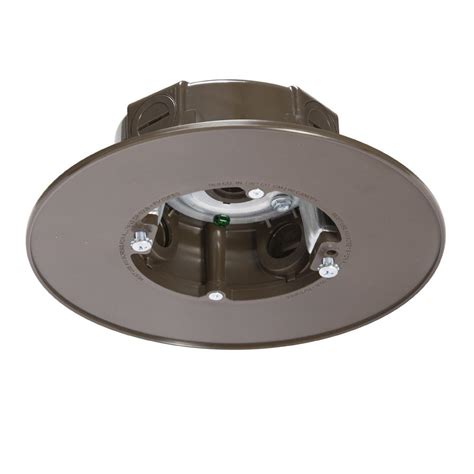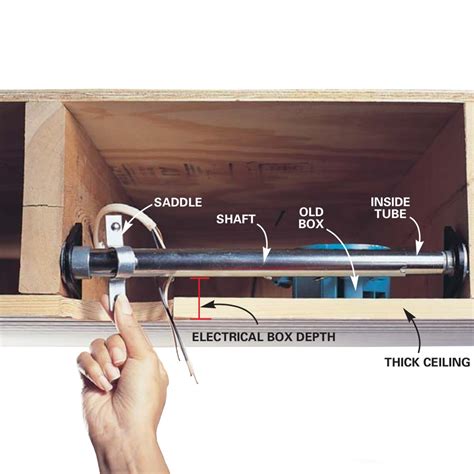ceiling fan junction box multiple conduits This method I’m visualizing is running the existing cable from the switch to a junction box, then running two new shorter cables from either end of that box to each of the . Float Mount includes a gatorboard block with sawtooth metal bracket for easy hanging. It'll give your Acrylic Print the appearance that it’s floating from the wall. Available in ³⁄₁₆" or ¾" depths. Recommended for smaller Acrylic Prints. Inset Metal Frames provide a modern, unframed look.
0 · weatherproof ceiling fan mounting box
1 · installing a ceiling fan box
2 · install ceiling fan junction box
3 · ceiling fan rated outlet box
4 · ceiling fan rated junction box
5 · ceiling fan outlet boxes
6 · ceiling fan junction box adapter
7 · adjustable ceiling fan box
Deep junction boxes, also known as extension rings or deep switch boxes, are used when additional space is required to accommodate extra wiring or devices. These boxes .
This method I’m visualizing is running the existing cable from the switch to a junction box, then running two new shorter cables from either end of that box to each of the . I have mine wired a bit different: Supply from panel -> Junction box -> Splits off to 2 wall switches for each fan (1 for light and 1 for fan motor). All of them work great without a hitch .
A ceiling fan junction box adapter is a small device that allows you to install a ceiling fan in a location that does not have an existing electrical box. It serves as a secure . I'm leaning towards calling in a professional because I can't figure out how one would connect a ceiling fan rated box. I thought I'd post here to find out 1) if my current .
This method I’m visualizing is running the existing cable from the switch to a junction box, then running two new shorter cables from either end of that box to each of the fans. Inside the junction box the hots are connected to hots, neutrals to neutrals, and grounds to grounds all via wire nuts and secured with electrical tape. I have mine wired a bit different: Supply from panel -> Junction box -> Splits off to 2 wall switches for each fan (1 for light and 1 for fan motor). All of them work great without a hitch and no over heating problems to speak of.
This is the easiest way to wire a ceiling fan with 3 wires in the box, but it won’t allow you to separately control lights and the fan motor. Options that do give you separate controls follow below. I had a basic light fixture mounted in my garage ceiling. I'm putting a ceiling fan in its place. After removing fixture, there's a square box with 3 conduit connections. I undid the connections and cut ceiling around box. I used a hammer and pry bar to get the box out. It was nailed to the joist.
1. Locate and isolate the black wire from the power supplied to the fan in the junction box (typically Romex wire). 2. Hold together both black wires and the blue fan wire. Twist a wire nut onto three to connect them together. 3. Hold together the bare wire on the white ceiling fan wire and white wire from wiring coming into the box.
Add a junction box at the end of the conduit and extend with additional conduit and new wires from that box. Note that any junction box must remain accessible, but this can include attic space with an access port. A ceiling fan junction box adapter is a small device that allows you to install a ceiling fan in a location that does not have an existing electrical box. It serves as a secure mounting point for your ceiling fan, ensuring that it is safely attached to your ceiling. I'm leaning towards calling in a professional because I can't figure out how one would connect a ceiling fan rated box. I thought I'd post here to find out 1) if my current hypothesis is correct and 2) to know what to expect when I get estimates. 10 ccc's in conduit has a reduction multiple of .50 that puts your 12 awg at 15 amps and your 14 awg at 12.5 amps. You can use the higher ampacity of the nm if the lower ampacity of the wires in conduit is not over 10 feet long and not longer than 10% of the higher ampacity length.
Lighting, Light Fixtures, Ceiling and Exhaust Fans - Switch, multiple outlets and fan wiring!! HELP PLEASE!! - Outlet was a flip switch. Was upgrading to a paddle switch and was going to fix the switch to have it turn the fan light off/on, whereas currently the switch controls the outlets in the room. Outlets have the

cnc yama seiki parts
weatherproof ceiling fan mounting box

This method I’m visualizing is running the existing cable from the switch to a junction box, then running two new shorter cables from either end of that box to each of the fans. Inside the junction box the hots are connected to hots, neutrals to neutrals, and grounds to grounds all via wire nuts and secured with electrical tape. I have mine wired a bit different: Supply from panel -> Junction box -> Splits off to 2 wall switches for each fan (1 for light and 1 for fan motor). All of them work great without a hitch and no over heating problems to speak of.
This is the easiest way to wire a ceiling fan with 3 wires in the box, but it won’t allow you to separately control lights and the fan motor. Options that do give you separate controls follow below. I had a basic light fixture mounted in my garage ceiling. I'm putting a ceiling fan in its place. After removing fixture, there's a square box with 3 conduit connections. I undid the connections and cut ceiling around box. I used a hammer and pry bar to get the box out. It was nailed to the joist. 1. Locate and isolate the black wire from the power supplied to the fan in the junction box (typically Romex wire). 2. Hold together both black wires and the blue fan wire. Twist a wire nut onto three to connect them together. 3. Hold together the bare wire on the white ceiling fan wire and white wire from wiring coming into the box.
Add a junction box at the end of the conduit and extend with additional conduit and new wires from that box. Note that any junction box must remain accessible, but this can include attic space with an access port.
A ceiling fan junction box adapter is a small device that allows you to install a ceiling fan in a location that does not have an existing electrical box. It serves as a secure mounting point for your ceiling fan, ensuring that it is safely attached to your ceiling. I'm leaning towards calling in a professional because I can't figure out how one would connect a ceiling fan rated box. I thought I'd post here to find out 1) if my current hypothesis is correct and 2) to know what to expect when I get estimates. 10 ccc's in conduit has a reduction multiple of .50 that puts your 12 awg at 15 amps and your 14 awg at 12.5 amps. You can use the higher ampacity of the nm if the lower ampacity of the wires in conduit is not over 10 feet long and not longer than 10% of the higher ampacity length.
installing a ceiling fan box
coal kettle metal box

"Internal cable clamps" are factory made "in the box." In the past, I've interpreted "internal" to mean inside the air volume of the box, which allows the box wall to neither be inside, or outside. But this language highlighted in red below doesn't allow me, in my opinion, to make that interpretation anymore.
ceiling fan junction box multiple conduits|weatherproof ceiling fan mounting box